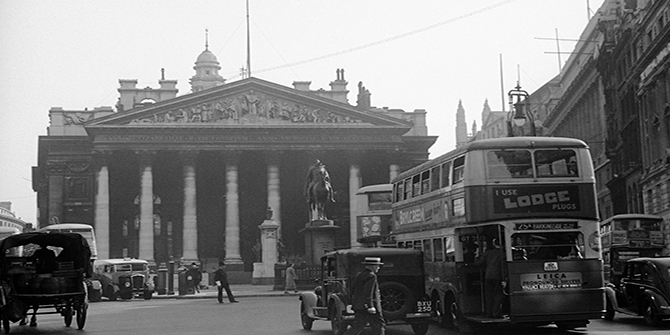 Heather Jones examines how the First World War changed British cultural attitudes to the monarchy, arguing that the conflict ultimately helped to consolidate the crown’s sacralised status.
Heather Jones examines how the First World War changed British cultural attitudes to the monarchy, arguing that the conflict ultimately helped to consolidate the crown’s sacralised status.
It was the war for ‘King and Country’. This First World War slogan appeared on postcards sent by men at the front to their families, on official war propaganda recruiting posters, even in commercial advertising. Most poignantly, these words remain today on countless war memorials all across Britain, often chosen by the war bereaved themselves to sum up what their loved ones had died for.
Yet the role of the British monarchy in the 1914-1918 conflict – and what it meant to wartime populations in the then United Kingdom of Great Britain and Ireland – has been virtually neglected by historians. What was British monarchism in the First World War? And did it really matter at all to ordinary people – men in the trenches or women in munitions factories?
 In 2008, I moved to live in London from the Republic of Ireland and the monarchist structure of the British state was immediately apparent to me, not to mention the huge public interest in royal weddings, births, and charitable work. Yet, it struck me as odd that the public focus on the monarchy has been disproportionately on its image as a ‘family’ rather than its wider historic national and international role. It quickly became clear that the twentieth-century British monarchy had been far more successful in quietly surmounting its war-related crises, such as the Second World War or Suez Crisis in 1956, than it had been in overcoming internal, familial ones. The leitmotifs of the monarchy’s recent history, in the media, in public debate, and in popular history books alike, are the 1936 abdication crisis, the 1997 death of Diana, the 2020 departure of the Duke and Duchess of Sussex, and not its remarkable achievement in surviving war crises in a twentieth-century marked by revolutions and anti-monarchism abroad. At the start of the century, there were only two major global powers that were successful republics – the USA and France. By its end, republics were by far the dominant form of state globally. Yet the monarchy’s political, symbolic, and cultural role – in particular in war and foreign policy crises – has been far less explored than the acreages of print devoted to its failures in the domestic and intimate sphere. Of course, for a monarchy, any familial crisis is simultaneously a dynastic one, particularly when the heir is concerned. The domestic is therefore political in a unique way, often raising constitutional questions. Nevertheless, the imbalance was striking.
In 2008, I moved to live in London from the Republic of Ireland and the monarchist structure of the British state was immediately apparent to me, not to mention the huge public interest in royal weddings, births, and charitable work. Yet, it struck me as odd that the public focus on the monarchy has been disproportionately on its image as a ‘family’ rather than its wider historic national and international role. It quickly became clear that the twentieth-century British monarchy had been far more successful in quietly surmounting its war-related crises, such as the Second World War or Suez Crisis in 1956, than it had been in overcoming internal, familial ones. The leitmotifs of the monarchy’s recent history, in the media, in public debate, and in popular history books alike, are the 1936 abdication crisis, the 1997 death of Diana, the 2020 departure of the Duke and Duchess of Sussex, and not its remarkable achievement in surviving war crises in a twentieth-century marked by revolutions and anti-monarchism abroad. At the start of the century, there were only two major global powers that were successful republics – the USA and France. By its end, republics were by far the dominant form of state globally. Yet the monarchy’s political, symbolic, and cultural role – in particular in war and foreign policy crises – has been far less explored than the acreages of print devoted to its failures in the domestic and intimate sphere. Of course, for a monarchy, any familial crisis is simultaneously a dynastic one, particularly when the heir is concerned. The domestic is therefore political in a unique way, often raising constitutional questions. Nevertheless, the imbalance was striking.
As a specialist in First World War Studies, I began to wonder in what ways the lived experience of total war in 1914-1918 might have affected the monarchy. I found that the reign of King George V is often overlooked, in favour of focusing on the salacious scandal of the abdication crisis that followed his death. There is even a common perception in biographies that George V was rather boring, a royal stamp collector. Yet, as king, George V personally visited the Western Front trenches on multiple occasions, consoled thousands of wounded troops in hospital, and even visited the victims of aerial bombardment in the East End of London within hours of German Gotha planes devastating their homes in 1917. What was the impact of all this, on the king himself and on public perceptions of him and the monarchy?
The result is my new book: For King and Country: The British Monarchy and the First World War. It is the first academic history of the monarchy and monarchism during the war. In the book I find that the wartime reign of King George V was foundational for the modern British monarchy and argue that the war ultimately sacralised and popularised the monarchy because of the multiple ways that it became associated with supporting the troops and the working classes and with commemorating the war dead. This helped what was a dynasty with German ethnic roots to survive both its problematic personal connections to the enemy and an age of wartime and post-war revolution.
I also discovered that the war saw the monarchy emphasise its image as a devoted family, as courtiers sought to present the king and queen in more human terms. The press endorsed this, depicting them as enduring the conflict like any other British parents, worried about their two eldest sons, Prince Edward and Prince Albert, who were serving in France and at sea in the navy respectively. This helped to create sympathy for the royals and make them seem more empathetic and relatable to their subjects, many of whom, particularly after the introduction of conscription, had loved ones at war. Presenting the royals as a model British family, rather than a wealthy European dynasty, gave them a more egalitarian image, more suitable for wartime, when austerity was the norm, an austerity that King George V and Queen Mary embraced, abandoning theatre, alcohol, pastry and a range of other pleasures for the duration of the conflict. It also helpfully contrasted them favourably with the ongoing luxury of the wartime German court, which still served caviar, and with the pre-war excesses of the Edwardian monarchy. In sum, the war message was that the British monarchy prioritised spiritual and moral values, of duty and family, over materialism and luxury.
Far from the First World War ‘modernising’ the monarchy, therefore, it actually enhanced its older image as a venerated, sanctified institution, one that was presented as distinctly and uniquely British and ancient and as supporting a specifically indigenous British form of democracy, embodied in a simply-living wartime royal family, accessible and relatable to its subjects. The image of the monarchy as a dutiful, hardworking, and religious family who epitomised all the best ideals of wartime Britishness was central to this.
This wartime propaganda depiction of a democratic British monarchy completely distinct from its continental peers (and indeed relations!), such as the German Kaiser, who were portrayed as wasteful, militarist, and materialist, established a hugely successful myth of British exceptionalism. British royals were different, the press claimed, and so did not need to be overthrown like their continental counterparts: Britain had monarchy by ‘consent’ of the people. This narrative helped protect the monarchy in the face of widespread socialist and anti-monarchist revolutions on the continent. This also helps to explain why the monarchy was situated at the heart of the British empire and British imperial identity in the imperial reforms that the war triggered. The monarchy, as a family, could embody the new post-war language of empire as a British global ‘family’ that was purportedly (if not in reality) harmonious.
It is this past that helps explain why royal intimate crises of family cause such reverberations, in comparison with the monarchy’s other roles. These changes ushered in a legacy that remains to this day – the idea of British ‘exceptionalism’ from continental Europe and the idea that the royal family must be a perfect, harmonious, familial model, epitomising sacred values, not conspicuous celebrity or materialism and wealth. In Britain, the war ultimately gave the monarchy a new social, deeply moral function as the symbolic custodian of national and imperial war grief, with the king chosen as the chief mourner, as head of the British national and imperial ‘family,’ at the burial of the unknown soldier at Westminster Abbey in 1920.
But the British monarchy did not survive everywhere. I have not forgotten my own Irish roots either and part of the book assesses why an anti-monarchist, republican revolution did break out in one part of these islands during the First World War. If the war strengthened the monarchy in Britain, in Ireland it polarised unionists and nationalists around the idea of whether a monarch as head of state was acceptable or not. By 1922, the question of having an oath of allegiance to the king in the Treaty settlement between a newly independent Irish Free State and Britain even helped trigger civil war among Irish nationalists. The case of Ireland shows that the British monarchy’s survival was not inevitable in the First World War; it was the choices it made, to prioritise sharing in the public war suffering in Britain, eschewing luxury, reaching out to the troops and war bereaved, and presenting itself as a ‘moral’ family, that mattered. Victory in the war helped, of course, but it was a very long time coming after 1914: royal popularity was sustained against revolution until 1918 by the monarchy’s policy choices.
The next time there is a major royal event in Britain, I will look at it rather differently than I did as a newcomer off the plane in 2008. Behind the mystique, the ceremony, and the tradition, I will see the central self-beliefs of the British state in operation – the hidden languages of British exceptionalism, of expectations of royalty, and of romanticised patriotism. I will understand better why they matter to the British public and remain popular, as does the monarchy itself. And I will remember how underpinning all this lies an appalling, calamitous war.
_____________________
 Heather Jones is Professor of Modern and Contemporary European History at University College London. From 2008-2018 she was an Associate Professor in International History at the London School of Economics and Political Science. Her book For King and Country: The British Monarchy and the First World War is published by Cambridge University Press.
Heather Jones is Professor of Modern and Contemporary European History at University College London. From 2008-2018 she was an Associate Professor in International History at the London School of Economics and Political Science. Her book For King and Country: The British Monarchy and the First World War is published by Cambridge University Press.







